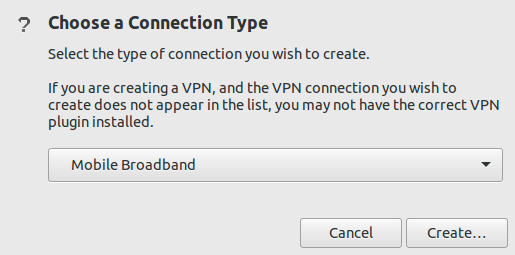Option Globetrotter MO40x 3G Modem (GTM 382) im Sony Vaio VGN-P11Z
tl;dr: Modem mit rfkill unblock wwan einschalten, modprobe hso Modul laden, im NetworkManager konfigurieren.
Langversion
Das Sony Vaio VGN-P11Z und bauähnliche 8"-Winz-Notebooks auf Intel Poulsbo-Basis bringen meist ein eingebautes UMTS-/3G-Modem mit. Unter Linux ist das, zumindest mit der Distribution Ubuntu 15.10, gut ansprechbar. Zuerst setzt man eine funktionierende Daten-SIM-Karte in den schmalen Slot unter dem Akku ein. Den Akku nimmt man dafür kurzzeitig heraus. Das kurzzeitig betone ich, da ohne Akku bei mir nie eine SIM-Karte gefunden wird - Akku also wieder einsetzen.
Erstmal nachsehen, ob das Option-GSM-Modem gefunden wird:
$ lsusb
Bus 001 Device 003: ID 05ca:18b2 Ricoh Co., Ltd Bus 001 Device 001: ID 1d6b:0002 Linux Foundation 2.0 root hub Bus 004 Device 001: ID 1d6b:0001 Linux Foundation 1.1 root hub Bus 003 Device 005: ID 044e:3017 Alps Electric Co., Ltd BCM2046 Bluetooth Device Bus 003 Device 001: ID 1d6b:0001 Linux Foundation 1.1 root hub Bus 002 Device 001: ID 1d6b:0001 Linux Foundation 1.1 root hub
Das WiFi-/Bluetooth-System ist eingeschaltet ("Wireless"-Schiebeschalter an der Front), daher ist das Bluetooth-Gerät sichtbar. Vom Option-Modem sehen wir aber noch nichts. Also sehen wir weiter nach, was blockiert wird:
$ rfkill list
0: sony-wifi: Wireless LAN Soft blocked: no Hard blocked: no 1: sony-bluetooth: Bluetooth Soft blocked: no Hard blocked: no 2: sony-wwan: Wireless WAN Soft blocked: yes Hard blocked: no 4: phy0: Wireless LAN Soft blocked: no Hard blocked: no 9: hci0: Bluetooth Soft blocked: no Hard blocked: no
Das UMTS- bzw. WWAN-Modul ist also ausgeschaltet. Daher taucht es nichtmal in lsusb (und damit auch nicht im NetworkManager) auf. Mit etwas Schwung schalten wir es ein:
$ sudo rfkill unblock wwan
$ rfkill list
0: sony-wifi: Wireless LAN Soft blocked: no Hard blocked: no 1: sony-bluetooth: Bluetooth Soft blocked: no Hard blocked: no 2: sony-wwan: Wireless WAN Soft blocked: no Hard blocked: no 4: phy0: Wireless LAN Soft blocked: no Hard blocked: no 9: hci0: Bluetooth Soft blocked: no Hard blocked: no
Damit sieht nun auch lsusb das Option 3G GTM 382:
$ lsusb
Bus 001 Device 003: ID 05ca:18b2 Ricoh Co., Ltd Bus 001 Device 009: ID 0af0:7601 Option Globetrotter MO40x 3G Modem (GTM 382) Bus 001 Device 001: ID 1d6b:0002 Linux Foundation 2.0 root hub Bus 004 Device 001: ID 1d6b:0001 Linux Foundation 1.1 root hub Bus 003 Device 005: ID 044e:3017 Alps Electric Co., Ltd BCM2046 Bluetooth Device Bus 003 Device 001: ID 1d6b:0001 Linux Foundation 1.1 root hub Bus 002 Device 001: ID 1d6b:0001 Linux Foundation 1.1 root hub
Nun können wir das passende Modul laden:
$ modprobe hso
Nach einigen Sekunden sollte das Gerät im NetworkManager auftauchen:
Nun kann in diesem Menü über "Edit connections" - "Add" die UMTS-Karte konfiguriert werden - Providername, APN, ggfs. Benutzername und Kennwort.
